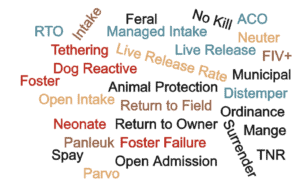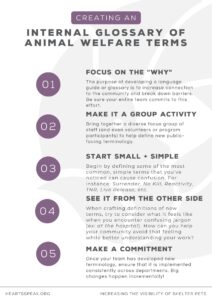“The limits of my language mean the limits of my world.” Ludwig Wittgenstein
I spend my days thinking a lot about words and the very specific language we use in the world of animal welfare. While imagery is critical to capturing attention, I’ve come to believe we really can’t separate marketing from the words and phrases we use. If photos and videos have the power to stop someone in their tracks, the words we speak or write are what make them stay with us — learning more and hopefully, taking action. They are the breadcrumbs that lead people back to our websites, pet adoption listings, and community resources.
 But oftentimes, we’re a bit too close to the situation to realize that the tried-and-true vocabulary that we use in our day-to-day work doesn’t translate at all to community members. Even those who have owned pets their whole lives, let alone new pet owners or those who may be adoption-curious, aren’t familiar with terms like reactive, or neonate. Then there’s the alphabet soup of TNRM, FIV+, HW- and RTO (that’s trap-neuter-return-management, positive for feline immunodeficiency virus, heartworm negative, and return to owner for those keeping track!).
But oftentimes, we’re a bit too close to the situation to realize that the tried-and-true vocabulary that we use in our day-to-day work doesn’t translate at all to community members. Even those who have owned pets their whole lives, let alone new pet owners or those who may be adoption-curious, aren’t familiar with terms like reactive, or neonate. Then there’s the alphabet soup of TNRM, FIV+, HW- and RTO (that’s trap-neuter-return-management, positive for feline immunodeficiency virus, heartworm negative, and return to owner for those keeping track!).
Take a moment and think back to before you worked with animals. Would you have known what “managed admission” shelters or “mange” or “panleuk” were? Probably not. But since then, these kinds of words have become a part of your daily life, and a part you are likely passionate about. And taken on its own, that’s not a problem—every field has jargon. But when that industry-speak makes its way into public communications things get complicated and confusing quickly.
“One should not aim at being possible to understand but at being impossible to misunderstand.” Marcus Fabius Quintilian
Why does this matter? Finding a shared language of pet ownership is critical to reaching more community members, whether your aim is to increase adoptions or connect with more of the folks who can benefit from outreach services. Put plainly, to save the lives of more animals, we need to step outside our bubble of jargon and insider-speak and into a space that serves the community as much as it serves our purposes.
What do we do about it? A good place to start is an internal glossary of terms. This is something that HeARTs Speak is hoping to help kick off but it will also need to be specific to each communities’ needs. The words below that we’re defining aren’t “bad words”, just terms that often mean more to us than to the community. Because of that, you may need to define them or use a new description to clarify their meaning and eliminate barriers.
Here are some examples:
-
- Animal Control → Animal Services; Pet Resources
- Surrendered → Came into care
- Return to Owner (RTO) → Returned to their home; Placed back into his/her home; Reunited with family
- Stray / Roaming → a lost pet found in the community
- Foster / fostering → Temporary placement; Pet-share; Petsitting for a shelter pet; Temporary caregiving; Short-term placement
- Demodex / Mange → Non-contagious, itchy skin condition. Tends to heal much faster in the low-stress environment that a short-term caregiver can provide through fostering.
- No Kill → Here you’ll need to define what this means for your specific organization. For example: “Animals who are candidates for adoption have no time limit in our shelters ― they can stay as long as they need to find their happy new beginning. In cases of severe or untreatable illnesses or behavior issues, we sometimes face the difficult decision to euthanize an animal after all other options have been exhausted.”

We’ve created an activity for you to use as your jumping-off point and hope you’ll use this to develop a much more comprehensive piece for your specific organization. Get the whole team involved, especially those folks regularly speaking with the public: You may find they’re already using ways to translate internal language into something more easily understood. Download the instructions here and the activity template here.
Once you develop your glossary, you can incorporate it into your brand guide and share it with staff, volunteers, fosters, and others who help advocate for your organization. Part of this exercise will likely include an “off-limits” terminology list for words like the pound, dog catcher, kill shelter, or dumped or other words that are considered divisive, exclusionary, or are not part of your organization’s brand. Help your team understand the intention of this document as a way to break down misunderstandings and reach a wider community of interested community members
“If you talk to a man in a language he understands, that goes to his head. If you talk to him in his own language, that goes to his heart.” Nelson Mandela
BONUS: While we’re speaking of words and language, are there other predominantly spoken languages in your community? It’s important to not only get your materials translated but also translated appropriately so that culturally specific or acceptable definitions can be subbed in for terms that may not have a direct translation. You may want to start by approaching community organizations, clubs, or college programs in your area and asking for their recommendations for translation services. You may find willing volunteers or good connections to professional translators!

